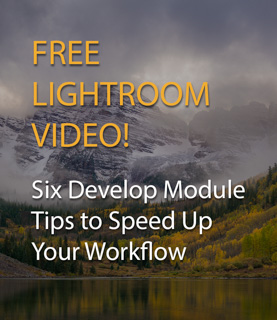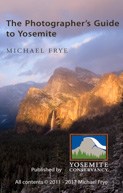In the Moment:
Michael Frye's Landscape Photography Blog
by Michael Frye | Aug 29, 2012 | Composition, Photography Tips, Vision and Creativity
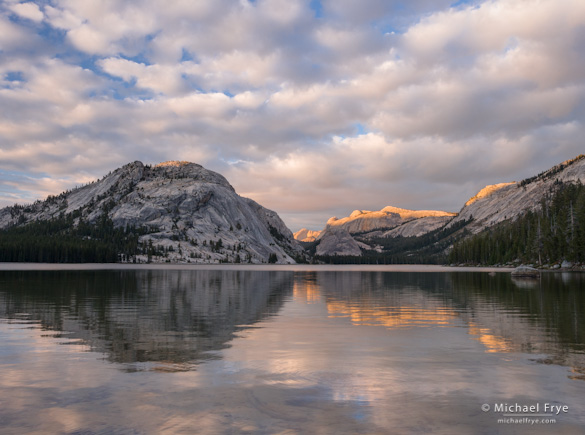
(A) Clouds and reflections, Tenaya Lake, Yosemite
At Tenaya Lake last week my workshop student and I watched and photographed a spectacular, constantly-changing cloud display for over two hours. I made many images, including the one at the top of this post (you can see two more here and here). With the lake in the foreground every composition included a prominent horizon line, so I was often thinking about where to place the horizon in the frame.
It’s not always an easy decision. If you’ve ever read any books on composition you probably learned about the rule of thirds. And when applied to horizons this means you should place the horizon a third of the way from the top or bottom of the photograph. And you probably also read that you should, at all costs, avoid putting the horizon in the center of the frame.
As many of you already know, I’m not a big fan of the rule of thirds. It’s too restrictive, too limiting when applied to the infinite number of possible subjects and situations a photographer can encounter. It’s useful sometimes, but shouldn’t be taken as dogma.
I think this applies to horizons as well. Sometimes putting the horizon a third of the way from the top or bottom works. Sometimes it’s better to ignore the rule and put the horizon right in the middle, or near the top or bottom of the frame.
(more…)
by Michael Frye | Aug 16, 2012 | Vision and Creativity

Reeds and Cloud Reflections no. 1
Planning
The future is uncertain, so we try to control it by planning. We think that if we do A and B the result will be C. But sometimes there are too many variables that we can’t account for, so the result might not be C—it could be D, or E, or even Z.
Photographers often try to plan. We imagine that if we go to a certain location at a certain time we’ll capture a certain photograph. Sometimes this works, but frequently the weather doesn’t cooperate or conditions aren’t right.
(more…)
by Michael Frye | Aug 15, 2012 | Announcements, Workshops
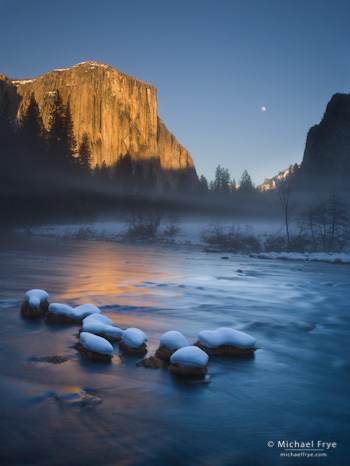
A January moonrise from Valley View, Yosemite
The Ansel Adams Gallery recently announced their 2013 workshops. I’m pleased to be teaching four Yosemite photography workshops for the Gallery next year—Landscapes in the Digital Darkroom: Mastering Lightroom (January); Spring Yosemite Digital Camera Workshop (April); Hidden Yosemite (July); and The Digital Landscape: Autumn in Yosemite (October).
As many of you know, I’m a big fan of Lightroom because it’s simple, yet powerful—easy to use, but sophisticated enough to get great results with almost any image. Last January was the first time I taught a workshop specifically focused on this tool: Landscapes in the Digital Darkroom: Mastering Lightroom. This class was popular, and a lot of fun, so we’ll be doing it again next January. Of course it’s not all computer work—the workshop includes field sessions to photograph snowy January landscapes, the rising full moon, and, if we’re lucky, clearing storms. I’m really looking forward to it!
The other three workshops—Spring Yosemite Digital Camera Workshop, Hidden Yosemite, and The Digital Landscape—have been very popular in the past, and sometimes fill quickly, so be sure to reserve space early.
And stay tuned… I’ll be announcing more workshops within the next month.
(more…)
by Michael Frye | Jul 30, 2012 | Announcements
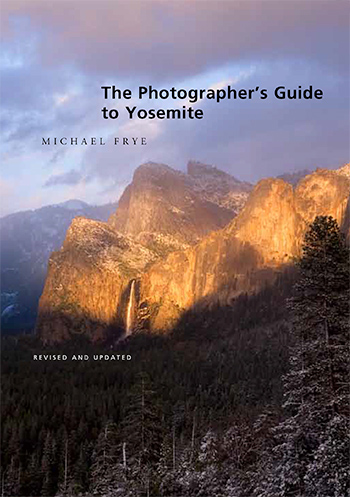 The new edition of The Photographer’s Guide to Yosemite is finally here! You can order signed copies directly from me, get it from the publisher, Yosemite Conservancy, or find it in the park at The Ansel Adams Gallery or Valley Visitor Center. It will be also available from Amazon soon.
The new edition of The Photographer’s Guide to Yosemite is finally here! You can order signed copies directly from me, get it from the publisher, Yosemite Conservancy, or find it in the park at The Ansel Adams Gallery or Valley Visitor Center. It will be also available from Amazon soon.
The new edition has three new locations, and completely revised and updated information for the entire park. You’ll find new tips specifically designed for digital photography, including Digital Camera Settings, White Balance, Exposure, and HDR and Exposure Blending, plus Depth of Field, Filters, Night Photography, and much more. Most of the 100+ photographs are new too, and the reproductions are excellent—a pleasant surprise for an inexpensive guidebook.
Of course if you prefer the convenience of having all the information in your smart phone or tablet, everything that’s in the new book is also in the iPhone and iPad app.
Thank you all for your patience! I hope you like this new edition even more than the original.
—Michael Frye
Related Posts: New Edition of The Photographer’s Guide to Yosemite: It’s Almost Here!; The Photographer’s Guide to Yosemite iPhone App is Available Today!
Michael Frye is a professional photographer specializing in landscapes and nature. He is the author and photographer of The Photographer’s Guide to Yosemite, Yosemite Meditations, and Digital Landscape Photography: In the Footsteps of Ansel Adams and the Great Masters, plus the eBooks Light & Land: Landscapes in the Digital Darkroom, and Exposure for Outdoor Photography. He has written numerous magazine articles on the art and technique of photography, and his images have been published in over thirty countries around the world. Michael has lived either in or near Yosemite National Park since 1983, currently residing just outside the park in Mariposa, California.
by Michael Frye | Jul 26, 2012 | Workshops
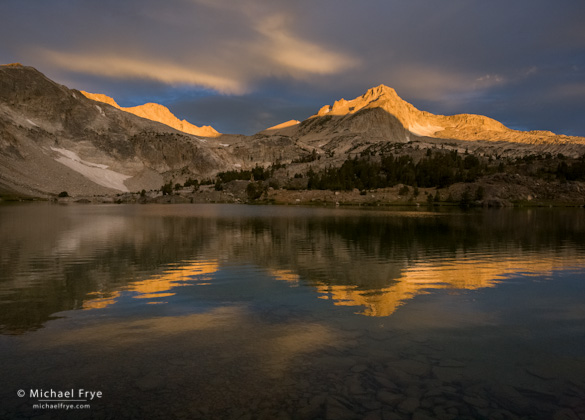
Sunrise illuminates North Peak. I like the rippled reflection, preserved by a fast shutter speed (1/90th sec).
Teaching my Hidden Yosemite workshop last week was so much fun. We had some wonderful clouds to make the skies more interesting, and a great group of people, plus it’s always fun to get away from the roads and into some beautiful areas that you just can’t drive to.
Weather forecasts before the workshop called for clear skies, but our first evening we photographed some amazing lenticular clouds, including two UFO disks over Mammoth Peak, and another formation to the north resembling an Imperial Star Destroyer. Later in the week the sun broke through overcast skies just before sunset and lit up the clouds over Gaylor Lakes, and the next morning we watched sunlight poke through more clouds to illuminate North Peak. And then it snowed. Meteorologists try to predict the future, which is a difficult job. This is one time when I’m glad they were wrong—the clouds definitely made things more interesting.
(more…)






